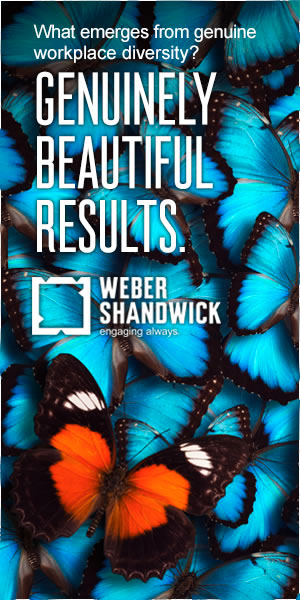In September, 4A’s released a survey which highlighted that 74 percent of advertising agencies are mediocre or worse at hiring diverse professionals.
DIVERGE asked Nancy Hill to discuss the results of the survey and talk about the importance of diversity.
Can you tell me about See It & Be It? Why is it so important and what is the goal of this?
The 4A’s has a long-standing commitment toward increasing diversity in the workplace. This year, we added new initiatives to tackle the issue, including conducting proprietary research, holding panel discussions across all 4A’s events, launching the See It & Be It content series on its website, and creating new, dedicated, diversity-related events.
The See It & Be It content is so important because if younger diverse professionals come up through the industry seeing how people who look like them can succeed, they can use that as motivation that they can succeed as well; that there is a seat at the table for them. It sets a precedent of great, diverse role models making strides in the industry.
What kind of feedback have you received from it?
It’s been well received to date! We have been promoting it throughout our member communications and have seen great traffic to the site as a result.
Your recent study showed two surprising results. Can you elaborate?
I’m not sure I’d say the results surprised me, but they did confirm a long-held belief we have here at the 4A’s: the ad industry has to do better at attracting, engaging and retaining diverse talent. The consumer study we conducted found that so long as the diversity is seen as genuine to a brand, it’s something consumers do want to see in their ads.
A few of the most interesting stats from our member survey are:
- When asked how the ad industry is doing when it comes to hiring diverse professionals, nearly half of respondents said the industry is terrible (20 percent) or not great (29 percent), and a quarter of respondents said it is mediocre.
- Approximately half of respondents said they believe agency culture is still discriminatory, but that the discrimination is not as overt as it used to be.
Why are diverse professionals still having a hard time finding positions/getting promotions?
I wish I knew the definitive answer to this. To a certain extent, I think there is a mindset of expediency in hiring. Essentially, we just keep hiring the same people over and over again because they have “the background” we think is necessary for a given position. This is limiting in terms of the pool of candidates and never opens the possibility for looking outside the norm of “qualified” candidates.
Why is the agency culture still discriminatory?
A commitment to diversity and gender equality starts at the top, it’s got to be intentional and companywide, but it won’t happen if the CEO and the other executives don’t mandate it.
Why is it so important to have diversity in these agencies?
Diversity in staff will lead to more creative, more impactful work that will engage a more diverse audience base.
When will your next study be and what will it include?
It’s not so much about conducting another study; we now have the benchmark. The industry can no longer deny there is a problem—now, we have to focus on creating programs and initiatives to help agencies achieve progress.
Can you tell me about your findings with your study with SSRS on advertising agencies using diversity in campaigns? Why are those results significant?
The 4A’s and research partner SSRS analyzed consumers’ opinions about diversity in ads and showed the vast majority of respondents agreed advertising has become more diverse in the past five years (81 percent). Seventy-four percent believe ads should reflect America’s diversity in a realistic way, and two-thirds of respondents (64 percent) believe advertising should ensure that Americans of all ethnicities are portrayed.
This means consumers are looking for diversity in their ads, and the ad industry should do all it can to speak to their audiences in a way they want.
With the elections and all this talk about sexual assault and the rape culture, I noticed a study you did in August on how many women in this field have experienced sexual harassment and discrimination. Can you tell me what was significant in those results?
The events in August reminded us that there is still much more work to be done on this front. The conversation is not “over”—not even close.
Here are a few stats from that survey:
- When it comes to sexual harassment, more than half the women surveyed had experienced sexual harassment at least once.
- The women also responded that there have been at least a few times when they have not received desired assignments or promotions because of discrimination (33 percent) and that there have been times when they were not included in making decisions that they should have been included in because of discrimination (42 percent).
- When asked to what extent they feel potentially vulnerable to discrimination at work in the advertising industry, more than half of the respondents said their gender made them feel either somewhat vulnerable (39 percent) or very vulnerable (15 percent), higher than any other attribute in the survey.
- Almost two-thirds of respondents either agree somewhat (40 percent) or agree totally (19 percent) that there were times when they personally experienced discrimination without recognizing it—only now do they see it was discrimination.
Do you think this has improved since August? Do you plan on doing another study regarding this topic soon?
It’s too soon to tell, but we have been having great conversations with executives in the industry who are committed to making strides in this area.
Why is it so important to have this dialogue on diversity?
Dialogue is a precursor to change: we must talk about it to inform the action we take; that’s how we can really make strides in addressing this issue.
Can you explain the mission of 4A’s and why the work you do is so important in today’s world?
The 4A’s underlying mission is to provide resources and guidance to make agencies successful. In today’s world, that means being inclusive and understanding that eradicating discrimination will not only make for a better workplace, it will make for a better work product on behalf of an agencies’ clients.


